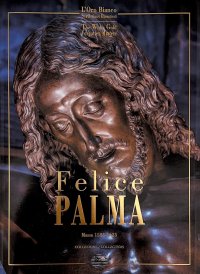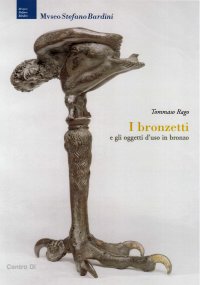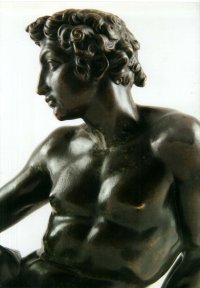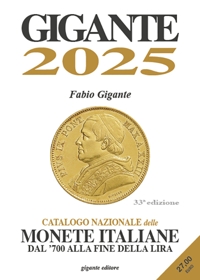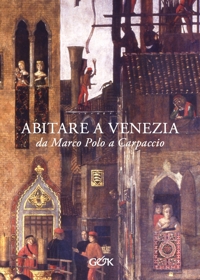Felice Palma. Massa 1583-1625. Collezione / Collection.
Texts by Andrei Cristina, Ciarlo Nicola, Federici Fabrizio, Claudio Casini and Sara Ragni.
Italian and English Text.
Pontedera, 2024; bound in a case, pp. 289, b/w and col. ill., b/w and col. plates, cm 24,5x34.
(L'Oro Bianco. Straordinari Dimenticati. The White Gold Forgotten Masters).
cover price: € 160.00
|
Books included in the offer:
Felice Palma. Massa 1583-1625. Collezione / Collection.
Texts by Andrei Cristina, Ciarlo Nicola, Federici Fabrizio, Claudio Casini and Sara Ragni.
Italian and English Text.
Pontedera, 2024; bound in a case, pp. 289, b/w and col. ill., b/w and col. plates, cm 24,5x34.
(L'Oro Bianco. Straordinari Dimenticati. The White Gold Forgotten Masters).
FREE (cover price: € 160.00)
Le botteghe del marmo
Italian and English Text.
Ospedaletto, 1992; bound, pp. 153, 10 b/w ill., 60 col. ill., cm 24x29.
(Immagine).
FREE (cover price: € 34.49)
Museo Stefano Bardini. I Bronzetti e gli Oggetti d'Uso in Bronzo
Edited by Nesi A.
Firenze, 2009; paperback, pp. 191, 102 b/w ill., 7 col. ill., cm 17x24,5.
(Museo Stefano Bardini).
FREE (cover price: € 30.00)
Bronzetti e Rilievi dal XV al XVIII Secolo
Bologna, 2015; 2 vols., bound in a case, pp. 729, ill., col. plates, cm 21,5x30,5.
FREE (cover price: € 90.00)
Aristide Maillol
Lorquin Bertrand
Skira
Translation by Taylor M.
English Text.
Milano, 2002; paperback, pp. 202, 123 b/w and col. ill., cm 24x28.
(Archivi dell'Arte Moderna).
series: Archivi dell'Arte Moderna
Other editions available: French Edition (ISBN: 88-8491-044-7).
ISBN: 88-8491-043-9 - EAN13: 9788884910431
Subject: Essays (Art or Architecture),Monographs (Sculpture and Decorative Arts)
Period: 1800-1960 (XIX-XX) Modern Period
Places: No Place
Extra: French Art and Culture
Languages: 
Weight: 1.45 kg
What is it about Maillol's work that prompts museums to pay over a million dollars for one of his prized, large sculptures? Moreover, why is his name virtually unknown by the general public? The answer to the paradox lies in the dichotomy inherent in the artworks themselves. His works are heroic, yet subdued; masterful, yet crude, classical, yet primitive, elevated, yet humble; obvious, yet profound; harmonious, yet disturbing. Such contrasts as these can only be portrayed in the work of a great artist.
Beginning his art career at the end of the 19th Century, Maillol determined to join the ranks of the avant garde, first as a decorative artist studying under Alexandre Cabanel (whose voluptuous Birth of Venus hangs famously in the Met in New York), then as a sculptor in the circle of artists who were to contribute to a new chapter in Art History. He was a member of the Nabis (the Hebrew word for prophet) artists, who were followers of Gauguin and whose names included Bonnard, Denis, and Vuillard. Maillol participated in the Nabis aesthetic, which strove for pure form and moved away from symbolism and verism. Maillol's greatest contribution during this period was his single-handed revival of the lost art of tapestry. As an exclusively decorative art, tapestry showed him the way to form for form's sake, which would become the anthem of early 20th Century art.
All the while, when viewing the paintings and tapestries of Maillol, one can sense a desire to draw out a singular, central form -- the female nude. At a time when women were still being girdled and covered from head to toe and obliged to serve submissive roles, the idea of strong and robust nude women in art was revolutionary. Whether Maillol intended to create a stir or not, he found in the female nude a passion that would consume him the rest of his long, prolific life. From a somewhat tentative, Nabi-esque beginning emerged a rekindling of a brilliant classicism, unmatched since the Greek Empire, that would speak to modern times from an ancient source. Balance, harmony, solidity, centeredness, permanence, monumentality and mass became Maillol's aesthetic and distinguished him from the stormy, tormented work of his great contemporary Auguste Rodin and the enchanting verisimilitude of Carpeaux before him.
Maillol's splendid new classicism would be made manifest in what would end up a mere handful of works compared to the oeuvres of prolific artists like Rodin and Picasso. Yet of these few works a high percentage can be considered great achievements in sculpture. Take his masterpiece La Méditerranée of 1902-05 -- it is a voluminous nude woman wearing a classically bunned hair style and sitting as though confined in a symmetrical triangle when viewed from the side. She sits in thought, one arm propping her upright at the back while the other arm rests its elbow on her bent knee while supporting her downcast head, which is also the apex of the triangle. Such a pose in nature would not be comfortable, let alone restful, by any means. However Maillol with his genius for balance and harmony of mass, has this impossible, even clumsy creature come off as serenity, grace, and introspection epitomized. So powerful is the effect, that a phenomenally tangible new space is formed by the sculpture's presence: she is not in your space, you are in her space of solitude and peace.
A similar sculpture with a very different mood is Night (1907-09). Here sits what could be the very same woman from Méditerranée only this time she is more in the form of a box, both knees bent upward and both arms folded upon them while her head falls on top of this self-imprisoned architecture of limbs. Her face is invisible as it peers straight down, through her arms and between her legs, as though into a dark well. Night is perhaps the most modern of Maillol's oeuvre. It is at once Classical as an ancient Greek work, Romantic as in Rodin's The Thinker, Expressionistic like the work (particularly German) that would emerge during the Great Wars, and Abstract as Constantin Brancusi and Henry Moore were to expound the possibilities of.
Maillol's first public commission was the Monument to Cézanne (1912-25). This supreme, flying couch of a woman left its mark on 20th Century giants like Picasso (in his classical period which featured giant-limbed, small-headed goddesses no less) and Moore (whose signature style features a bench-like, classically reposed, abstract woman). Monument would be a mother to Maillol's late period masterpieces like The Mountain (1937), Air (1938), and The River (1938-43). Although undocumented, the clear influence of the great American Deco sculptor Paul Manship is evident in these late works, which each bear characteristics of Manship's most public of masterpieces: Prometheus in Rockefeller Plaza. Of these, The River is an enigma that will forever leave the book open on Maillol. A reclined, yet animated goddess of a woman is frozen in a kind of mysterious half-exstacy half-torment. At once a Medusa and a languid beauty, this work was based on the idea of a fallen stabbing victim to symbolize the abolition of war. In the end, these polar initiatives become a sublime commingling in art the likes of which the world had not seen since the ancient Laocoon Group of Greece.
Why Maillol is not more widely known is perhaps a testament to how thoroughly his work has filled a void we today take for granted. A void where the simple, classical abstraction of the human form can communicate epic poems from a place of immortal stillness. Our contemporary frenzy today can no more comprehend a Maillol than the patient growth of a tree. Maillol is a sage that awaits the next chosen.
Fabio Gigante € 25.65
€ 27.00 -5 %






